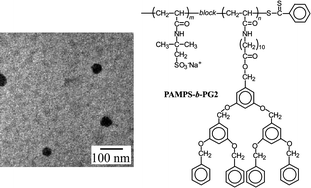Self-association behavior in water of an amphiphilic diblock copolymer comprised of anionic and dendritic blocks
Abstract
Well-defined amphiphilic

* Corresponding authors
a
Department of Materials Science and Chemistry, Graduate School of Engineering, University of Hyogo, 2167 Shosha, Himeji, Hyogo, Japan
E-mail:
yusa@eng.u-hyogo.ac.jp
Fax: +81 79 266 8868
Tel: +81 79 267 4954
b
Graduate Institute of Engineering, Jing-Cheng Honors College, National Taiwan University of Science and Technology, 43, section 4, Keelung Road, Taipei, Taiwan
E-mail:
imae@mail.ntust.edu.tw
c
Faculty of Engineering, Fukui University of Technology, 6-3-1 Gakuen, Fukui, Japan
E-mail:
morisima@fukui-ut.ac.jp
Well-defined amphiphilic

 Please wait while we load your content...
Something went wrong. Try again?
Please wait while we load your content...
Something went wrong. Try again?
S. Yusa, Y. Shimada, T. Imae and Y. Morishima, Polym. Chem., 2011, 2, 1815 DOI: 10.1039/C1PY00111F
To request permission to reproduce material from this article, please go to the Copyright Clearance Center request page.
If you are an author contributing to an RSC publication, you do not need to request permission provided correct acknowledgement is given.
If you are the author of this article, you do not need to request permission to reproduce figures and diagrams provided correct acknowledgement is given. If you want to reproduce the whole article in a third-party publication (excluding your thesis/dissertation for which permission is not required) please go to the Copyright Clearance Center request page.
Read more about how to correctly acknowledge RSC content.
 Fetching data from CrossRef.
Fetching data from CrossRef.
This may take some time to load.
Loading related content
